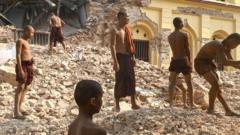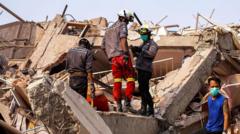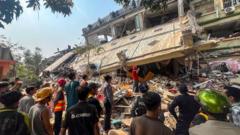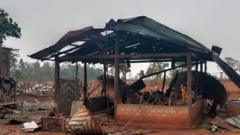The recent earthquake in Myanmar has caused extensive damage, claiming over 1,000 lives and leading to the unexpected collapse of a high-rise building in Bangkok, highlighting vulnerabilities in construction practices.**
Myanmar Earthquake Triggers Unlikely Consequences in Bangkok as Buildings Collapse**
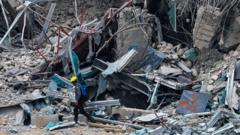
Myanmar Earthquake Triggers Unlikely Consequences in Bangkok as Buildings Collapse**
A 7.7-magnitude earthquake in Myanmar results in a rare high-rise building collapse in Bangkok, raising questions about construction standards and geological impacts.**
A 7.7-magnitude earthquake struck Myanmar on Friday, resulting in over 1,000 casualties and severe structural damage across the region. Despite Bangkok being over 1,000 kilometers (approximately 621 miles) from the earthquake's epicenter, an unfinished high-rise in the city was unexpectedly brought down.
The driving force behind this earthquake lies in the complex movements of tectonic plates beneath Myanmar, a region notorious for seismic activity. Travelled by a fault known as the Sagaing fault—extending nearly 1,200 kilometers (746 miles) north to south—the earthquake was classified as a "strike-slip" event, characterized by horizontal shifting of the plates.
This earthquake was particularly destructive due to its shallow depth of just 10 kilometers from the surface, which amplified the shaking felt far from the epicenter. Additionally, its significant magnitude released energy comparable to that of the Hiroshima atomic bomb. The unique geological characteristics of Bangkok, where the soil is soft, further intensified the seismic waves, contributing to the unusual disaster.
The sole building to collapse in Bangkok was the under-construction headquarters for the auditor-general's office. Prior to 2009, Bangkok did not enforce robust earthquake-resistant building codes, leaving many structures vulnerable. Interestingly, while the collapsed building was new and should have adhered to updated standards, architects employed a "flat slab" construction method—which has been criticized for its lack of seismic resistance.
In Myanmar, cities like Mandalay faced the brunt of the earthquake's impact, suffering from poorly constructed buildings unprepared for such events. Factors like poverty, political instability, and inadequate construction regulations have hampered the ability to enforce effective earthquake-proofing designs. Moreover, many structures were positioned in vulnerable areas, such as floodplains, making them susceptible to a phenomenon known as liquefaction, which further compromises their stability.
Experts warn of potential aftershocks, raising ongoing concerns about the structural integrity of both existing and future buildings in the region.

